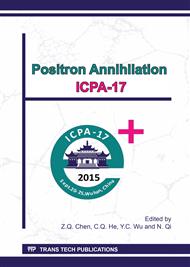p.84
p.91
p.96
p.100
p.104
p.108
p.113
p.117
p.122
The Evolution Behavior of Defects in the Nanofilms of W/Cu and W Probed by Doppler Broadening Positron Annihilation Spectroscopy
Abstract:
W/Cu multilayer nanofilms and pure W nanofilms were prepared in pure Ar and He/Ar mixing atmosphere by radio frequency magnetron sputtering method. The defect evolution of the samples was characterized by Doppler broadening positron annihilation spectroscopy (DB-PAS).The results show that plenty of defects can be produced by introducing helium (He) into W/Cu multilayer nanofilms. With the natural storage time increasing, the helium located in the near surface of W/Cu multilayer nanofilm would be released gradually and induce the coalescence of the helium related defects due to the diffusion of the helium and defects. In addition, the pure W nanofilms were irradiated by 30 keV helium ions and 40 keV hydrogen (H) ions in sequence at room temperature. From the DB-PAS analysis, it can be shown that a large number of vacancy-type defects are produced due to the He and/or H irradiation. H ions would be trapped by He related defects and produced He-H-V complexes.
Info:
Periodical:
Pages:
104-107
Citation:
Online since:
March 2017
Authors:
Keywords:
Price:
Сopyright:
© 2016 Trans Tech Publications Ltd. All Rights Reserved
Share:
Citation:


